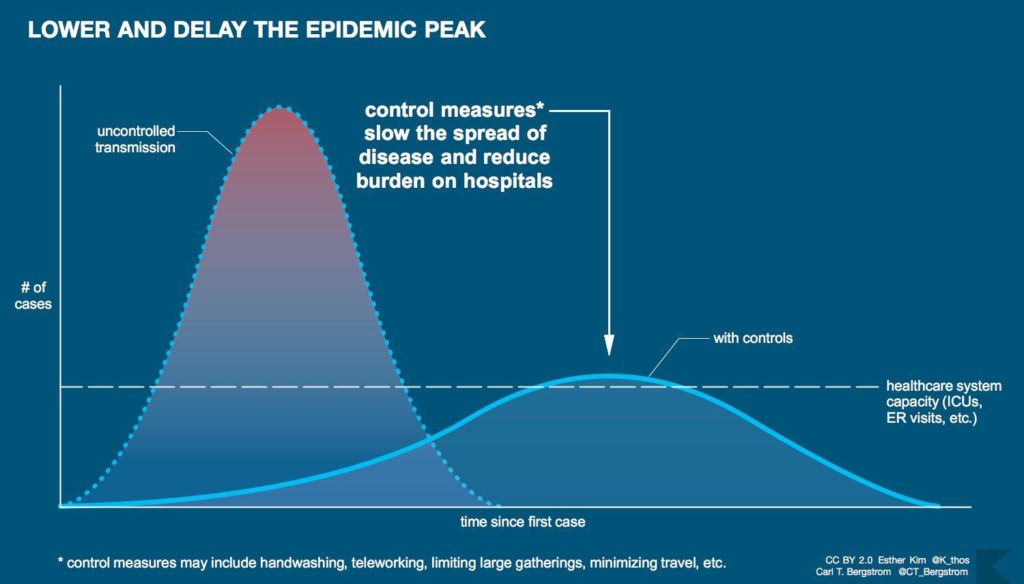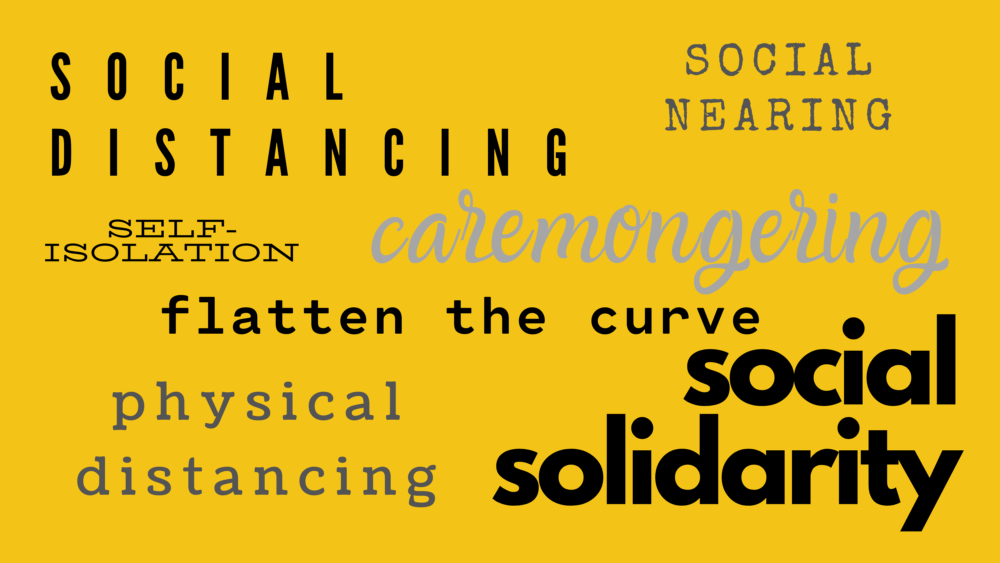Social distancing, social solidarity and flattening the curve
COVID-19’s top 7 terms
COVID-19 has not only brought heightened attention about personal hygiene practises, but also heightened attention to the language we use to talk about it. Here’s the top 7 terms linked with coronavirus.
1. Social distancing
Social distancing is an original term coined to describe the practice of putting distance between people, in order to stop the virus’ spread. It includes refraining from physical touch like shaking hands, hugging and kissing, and maintaining a certain distance between people when in public places or gatherings.
Social distancing does not refer to isolating ourselves from others completely but simply taking additional precautions in our physical nearness to others, particularly in public.
Some people have disputed the term’s usefulness, saying it communicates the concept of adding distance to people’s relationships and connectedness with wider society, rather than mere physical distancing.
2. Physical distancing
Physical distancing is the term many people are using instead of social distancing … now that everyone’s had some time to think about it. It’s basically the same thing, though, without any unintended implications about people isolating themselves relationally.
3. Social solidarity
Some have suggested ‘social solidarity’ is a good term to use, as a way of emphasising the need to not only empathise, but actually deepen our commitment to others in society – even as we put distance between our physical bodies. Social solidarity encourages standing with others in unity, to ensure no vulnerable people get forgotten or additionally suffer during this time.
4. Social nearing
A similar, helpful term to social solidarity – and suggested by John Dickson – is social nearing. As we physically put distance between ourselves and others, social nearing indicates how we should nonetheless make a deliberate effort to connect relationally (more than usual).
5. Flattening the curve
With no vaccine or medication yet available to treat COVID-19, infectious disease experts say the only way to treat the virus is to “flatten the curve”.
The “curve” referred to is the one showed on a graph of the number of people who are projected to contract COVID-19 over a period of time. It’s not actually the number of people who definitely will contract the disease, but experts’ best projections (based on the spread of the disease so far).
Professor Carl Bergstrom developed the “flatten the curve” graph that has become a global infographic. He is an evolutionary biologist at the University of Washington who studies emerging infectious diseases. He says it’s helpful to think of two scenarios in an epidemic: one where the spread is rapid, and one where public health measures slow down the growth of the outbreak.

Image: Esther Kim & Carl T. Bergstrom / Wikimedia Commons
“Flattening” the curve refers to collective action that will stop the spread of the disease and, therefore, “flatten” the shape of the disease’s projected spread when graphed.
Which leads us back to “social distancing”/ “physical distancing” – the public health measure experts say is the only way to limit the disease’s spread.
6. Self-isolating
This leads us to “self-isolating” – the term used to describe an individual’s need to isolate themselves because they have been or suspect they may have been in contact with a person infected with COVID-19. However, many have expanded this definition to refer to a growing trend of people shutting themselves off from social activities and connections which they usually are involved with. While they are not directly suspected of having COVID-19, they are staying home more and more, to avoid public places and other opportunities for possible interpersonal contact.
Self-isolation has helped curb the increase of coronavirus transmission
In Australia, people are also required to self-isolate in their home or in a hotel if they’ve arrived in Australia from overseas after March 15, even if they are not showing any symptoms. This is because symptoms of COVID-19 can take up to two weeks to appear. Those who should be self-isolating for the above reasons but who do not, risk being fined up to $63,000 if reported to the police.
Self-isolating means staying indoors and having any supplies or deliveries left at your door. If showing symptoms, it is recommended that people try to further self-isolate from others in the household, by taking measures like using a different bathroom, sleeping in a different bed to their partner, wearing a mask, refraining from cooking for others and even remaining secluded in a different part of the house from others, as much as is if possible.
It is also recommended that surfaces in the home be cleaned frequently and thoroughly and that the whole household observes stringent personal hygiene.
Elsewhere, self-isolation has helped curb the increase of coronavirus transmission, with cases steadying in countries such as China and South Korea.
“It’s spread the opposite of panic in people, brought out community and camaraderie.” – Valentina Harper
7. Caremongering
Last, but not least, ‘caremongering’, according to a BBC report, is a term that began in Toronto, Canada, with a Facebook group and has now become a global movement.
The first “caremongering” group was reportedly set up by Mita Hans with the help of Valentina Harper and her friends.
“Scaremongering is a big problem,” Valentina explained. “We wanted to switch that around and get people to connect on a positive level, to connect with each other.
“It’s spread the opposite of panic in people, brought out community and camaraderie, and allowed us to tackle the needs of those who are at-risk all the time – now more than ever.”
Email This Story
Why not send this to a friend?




